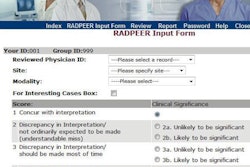Current image-sharing methods based on CDs are burdensome to both patients and providers alike and also raise privacy concerns. However, researchers from Wake Forest University have developed a patient-controlled prototype image-sharing framework that aims to tackle those problems.
In an article published online in the Journal of the American Medical Informatics Association, the study team discussed how their approach, called the Patient Controlled Access-Key Registry (PCARE), provides patients with control over the image-sharing process without actually accessing images. Separating the processes of image control from image access enables significantly improved functionality and performance for a patient-controlled image-sharing network, according to the authors.
"A hybrid design that combines both patient-facilitated and organization-facilitated sharing networks is more effective at enabling image sharing with both protection of patient privacy and boosting of physician workflow," said Dr. Yaorong Ge of Wake Forest School of Medicine's department of biomedical engineering.
Ge and Dr. Jeff Carr, a professor of radiology, cardiology, and public health sciences at Wake Forest Health Sciences, had developed a technical framework for research-oriented image sharing as part of their work to coordinate the sharing of medical imaging data for population-based cardiovascular research.
"But we realized a number of years ago that the clinical care arena is missing this critical capability that both effectively protects patient privacy while boosting physician workflow," Ge told AuntMinnie.com. "We believed the solution lies in effectively enabling patient participation in this process."
Carr noted that the burden of dealing with CDs affects the entire system, from patients to staff, nurses, and physicians.
"But most importantly, by not making existing imaging information available when needed by patients and doctors, we are creating situations where errors and duplicate testing are more likely," Carr said.
PCARE
To improve upon the shortcomings of current image-sharing methods, the researchers developed their PCARE framework. The framework features a PCARE master server and a network of PCARE facility servers, one of which is placed at each participating facility. Each node on the network can either be an independent healthcare enterprise or an organization-controlled image-sharing network such as a health information exchange, according to the researchers (JAMIA, August 11, 2012).
In a key difference with other patient-driven sharing networks such as personal health records (PHRs), PCARE does not deal with actual clinical data. Instead, PCARE is a collection of access keys that uniquely represent clinical datasets, according to the group. Generated by an imaging facility after patient authorization, these unique access keys are tokens that serve as a secure electronic conduit to the actual dataset.
The access key contains a limited number of patient attributes and metadata that describe the dataset. These are encrypted and digitally signed; only the patient and the facility can decrypt and authenticate the content, according to the researchers. Facility-specific URLs are also included to provide the links to where the imaging data can be retrieved.
"To ensure strong security, the facility must update the access key periodically or whenever relevant information changes -- for example, when a facility's URLs change," the authors wrote. "For finer control of access, multiple access keys may be generated for each patient to allow access to different parts of a patient's health record."
The PCARE master server also includes a master patient index (MPI).
"In the proposed framework, we fully leverage patient participation in their healthcare process by enabling patients to establish the linkage between their local identity and the PCARE identity as a part of their normal registration or check-in process," they wrote. "The MPI created through such physical verification processes eliminates major sources of error in conventional MPI linkage systems."
Patient portal
A patient control portal, the third major component of the PCARE master server, allows patients to control how their images are shared, but it does not provide them with access to the actual image data.
"The access keys in PCARE provide metadata information about the type of studies that are sufficient for patients to make their sharing decisions," they wrote. "Therefore, our patient portal is called a patient control portal to emphasize that in the portal patients are admitted to access keys rather than actual health data, and that patients control the exchange of health data rather than view or manipulate the actual content of health data."
The access keys record patient authorization parameters for who can access what data elements under what conditions and during what time period. Each PCARE account also maintains an audit log.
Located at each participating site, a PCARE facility server serves as the gateway for each institution.
Upon receipt of outside studies, the PCARE system populates them onto the local RIS/PACS, which saves the time of loading and viewing CDs and provides better integration into local electronic workflow, Carr said. Full-fidelity DICOM images and the official report with full provenance are given by the provider responsible for the study.
"We have found that physicians vary widely in their needs to see all the images and the report," Carr said. "So, in our opinion, the physicians need both so they can choose without having to jump through additional hoops and slow the patient care workflow."
Are patients ready?
Of course, a patient-controlled model won't work if patients don't participate. However, Ge and Carr told AuntMinnie.com they believe that patients are now ready to take a more active role in the image-sharing process.
The current approach of transporting CDs and DVDs incurs tremendous costs in terms of lost time for patients and physicians, Carr said. Patients have to go get the CDs and physically transport them, while physicians have to load them into their local systems to view them.
In addition, from a legal and regulatory perspective, the PCARE approach closely mirrors current practice in which a patient picks up a CD and delivers it to whomever they wish, Ge said.
"With our platform, the patient is verified at the facility during registration, and can grant access to doctors electronically as soon as they register at the facility -- even before the exam is completed -- or days later without having to make additional trips to either pick up or deliver the CD/DVD," he said. "Moreover, the patient grants access without having to pay to store or manage the data on some type of cloud service."
In another aspect of the project that wasn't included in the study, the researchers performed in-depth interviews with patients, providers, and staff. These discussions determined that managing the workflow for images on CDs/DVDs is a universal problem, Carr said.
"In talking to our patients, they are very receptive to the idea of registering for a service that allows them to interact with a 'kiosk' and designate that their doctors can have access to their medical images," Carr said.
The researchers hope that their work can lead to a new image-sharing design or even general medical data-sharing networks that can go beyond private or public regional sharing networks into cross-network, cross-state, or even a national sharing network, Ge said.
"When you look at many major metropolitan areas, they tend to be in locations along rivers or other natural boundaries that form state borders; thus, healthcare service regions often extend across political boundaries (state lines) and sharing of images needs to handle the ability to share data between unaffiliated providers," Ge said. "In our surveys, a common-use case was to get images from one location to a specialist the patient would like to get a second opinion from, or to guide their care."
Efforts are now under way to further develop the framework and perform a full implementation in a clinical setting, according to the authors. They are searching for a partner and funds to perform a clinical study of the technology.




















